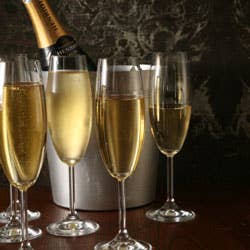
Vintage Beauties
Wines sparkle and bubble throughout the grape-growing world, but none combine delicacy and depth as gracefully as the wines made in the region roughly 90 miles east of Paris known as Champagne. True champagne remains unequaled in terms of subtlety, complexity, and, certainly, status. Even wine drinkers who justifiably sing the praises of California's sparkling wines, Italy's proseccos, or Spain's cavas tend to splurge on French champagne when it comes time to toast the New Year or another special occasion. But champagne can do more than ring out the old and ring in the new. It is above all a wine—indeed, one of the world's great ones, the object of centuries' worth of artisanship and refinement—and it can be enjoyed like any other fine wine: before and during a meal.
In this regard, vintage champagnes—the small minority of wines from that region made from a single, choice harvest—are my favorite. They cost only slightly more than the nonvintage blends that dominate the market, but their taste is almost as compelling as that of the super-expensive cuvees (that is, specific blends or batches) like Moet & Chandon's Dom Perignon and Louis Roederer's Cristal. They aren't bargains (high demand and limited production all but ensure that no champagnes are), but good vintage champagnes display a remarkable finesse that makes them more than worth the expense, especially when savored with a meal.
Dry, or brut, vintage champagnes (see The Six Main Styles of Champagne) are especially versatile partners at the table. They complement fried and spicy foods, egg dishes, and all sorts of soups (including ones like **Lobster Bisque. I've particularly enjoyed vintage bottles with omelettes, oysters, tempuras, tamales, and—in a pairing that has forever spoiled me for the customary accompaniment of beer or sake—sushi. The only thing most vintage champagnes don't go well with is dessert, as any brut champagne comes across as tart and even sour in the company of sugar.
The complexity and deep, long character that make vintage champagnes such excellent food wines owe to a unique set of circumstances. Because the Champagne region has only a marginal climate for grape growing, not every harvest yields first-rate wine. Vintners thus fashion their nonvintage blends, which constitute the vast majority of champagne sold worldwide, by combining wines from lesser vintages with reserves from better ones. Occasionally, however, if the weather has been warm enough, without too much rain during the harvest, and if the grapes have ripened adequately so as to yield a sufficiently large crop, a portion of the wine from a single vintage may be deemed good enough to be bottled on its own.
These single-harvest wines, then, invariably are made with only high-quality grapes; in the Champagne region, that always means chardonnay, pinot noir, pinot meunier, or some combination of the three. What's more, those grapes frequently come from the best vineyards, often the ones classified as premier cru or grand cru. Top-tier grapes translate into wines with especially memorable aromas and flavors, precisely the qualities that make them so gratifying when paired with food.
That many of these single-harvest wines bear a striking resemblance to much more expensive luxury or prestige champagnes like Cristal and Dom Perignon is no accident. Like vintage champagnes, those famously coveted cuvees are vintage-dated and made from the best grapes harvested from the most prized vineyards during a superior year. And yet most vintage champagnes are sold at one-half to one-quarter the price of the same producer's luxury cuvee, which the less expensive wine may well resemble closely in both quality and style.
Vintage champagnes offer still other advantages. Most are aged for at least two or three years longer than nonvintage blends are. That extra time allows them to harmonize fully, so they are almost always ready to drink when purchased. Yet these wines can also age effortlessly at home, becoming mellower and toastier with time in the bottle. For me, young, nonvintage champagne, with all its fizzy zeal intact, proves perfect for toasts and late-night revelry. But at a grand holiday feast, vintage champagne's subtler, more layered personality wins out. In fact, these wines are cause for a celebration of their own, no matter the time of year.
Keep Reading
Continue to Next Story










